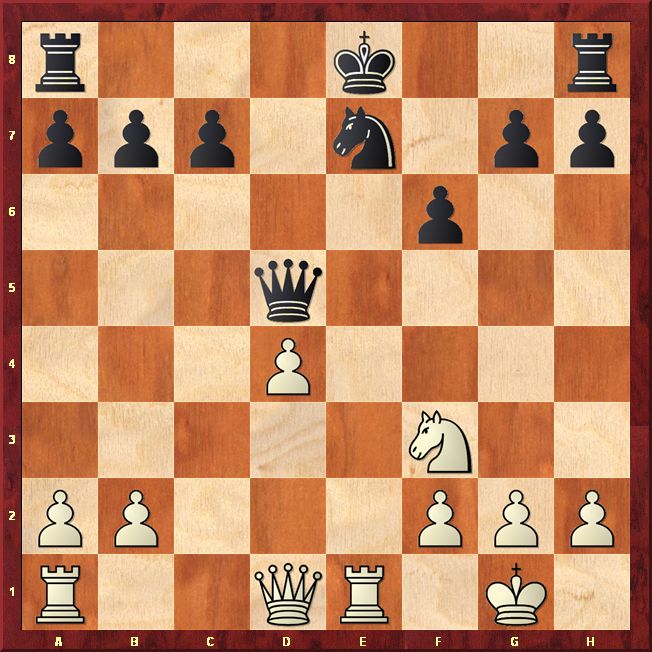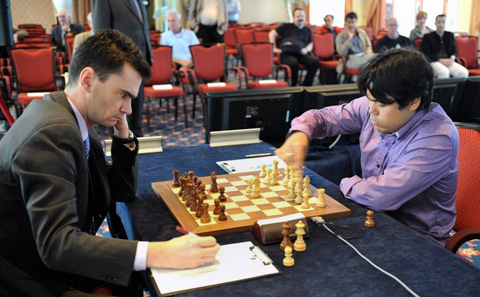Enough is enough and you throw in the towel. That's the elegant way to give up in boxing. In chess, there are more ways of resigning a game before you get actually mated. The manner Curt von Bardeleben did it 115 years ago during the legendary tournament at the English seaside resort of Hastings, still generates controversy. Having been brilliantly outplayed by William Steinitz, the German count got up from his chair, left the tournament hall and disappeared in the streets. Consequently, he lost on time.
Von Bardeleben was playing the tournament of his life and in the first nine rounds went undefeated, scoring six wins and three draws. Could a single loss upset him so much? Was he disgusted because he was being thoroughly and beautifully crushed? Was it simply an emotional outburst ? Did he talk to Steinitz about his intentions? And was it before he left the hall or the next day? Can we look at it as a fine gesture of a German nobleman, trying to spare his colleges from being disturb by an applause usually awarded to magnificent victories? We know he spoke about it with the organizers. Can we believe the newspaper accounts or should we let imagination rule?
The speculations should not distract from the actual game. The winner, William Steinitz, became the first official world chess champion in 1886, defeating Johann Zukertort in a match played in the United States. But he was considered the world's best chessplayer from 1866, when he defeated Adolf Anderssen, to 1894, when he lost to Emanuel Lasker.

Steinitz created his masterpiece against von Bardeleben on a very hot Saturday, August 17, 1895.
It was awarded the top brilliancy prize of the Hastings tournament and earned Steinitz five pounds sterling. The committee noted that "the whole of the play was extremely artistic and beautiful, as well as brilliant." Steinitz considered it the best game of his chess career.
During the last 115 years several commentators tried to decipher the game. It is a shining example of what happens to a king left in the middle of the board and it is being cited in many chess manuals. It adheres to one of Steinitz's positional principles: the player with the advantage must attack. GM Igor Zaitsev analyzed it scrupulously as a model game for his Russian book Ataka v silnom punkte (Attacking the strong point). Steinitz leads his combination with a pawn sacrifice on a square that seems to be overprotected by Bardeleben's forces. The seemingly impossible becomes possible. Steinitz proceeds with a rook sacrifice, leaving all his pieces under attack. As long as the rook is not taken, the German is fine. But the rook is able to dance along the seventh rank and Steinitz finds a way to force the capture. An amazing feast!
I believe that many brilliant games are created out of desperation and it may be the case with Steinitz's game. Had he waited with the pawn sacrifice one more move, von Bardeleben would have blocked the isolated pawn, consolidated his forces and even looked for a win. Instead, Steinitz composed an immortal game.
Steinitz - von Bardeleben
Italian Game
Hastings 1895
1.e4 e5 2.Nf3 Nc6 3.Bc4 Bc5 4.c3 Nf6 5.d4 exd4 6.cxd4 Bb4+ 7.Nc3?! (Steinitz loved this old gambit line, published already in 1620 by Greco. The solid 7.Bd2 Bxd2+ 8.Nbxd2 d5 9.exd5 Nxd5 10.Qb3 leads nowhere after 10...Na5.) 7...d5? (A wrong reaction. Correct is 7...Nxe4! 8.0-0 Bxc3 9.bxc3 d5 10.Ba3 and now instead of 10...Be6, played in the game Steinitz-Schlechter, Hastings1895, Black can simply play 10...dxc4 as Lasker did in the 1896 world championship match and beat Steinitz twice.
The Moller Attack 7...Nxe4! 8.0-0 Bxc3 9.d5!? was not known at that time, but it is harmless after 9...Ne5!? 10.bxc3 Nxc4 11.Qd4 0-0 12.Qxe4 b5 or 12.Qxc4 Nd6 13.Qd3 Qf6 14.Re1 b6 15.Bg5 Qf5 16.Qxf5 Nxf5 17.g4 f6 18.Bf4 Nd6 19.Bxd6 cxd6 20.Nd4 Bb7 as in the game Gashimov-Dominguez Perez, Nice 2010. It was drawn in 37 moves.) 8.exd5 Nxd5 9.0-0 Be6 (After 9...Nxc3 10.bxc3 Bxc3 11.Qb3! Bxa1 12.Bxf7+ Kf8 13.Ba3+ Ne7 14.Rxa1 a5 15.Re1 wins, for example 15...a4 16.Qc4 b5 17.Rxe7 bxc4 18.Rxc7+ Qe7 19.Rxe7. Also after 9...Bxc3 10.bxc3 Nxc3 11.Qe1+ wins a piece.)

10.Bg5!? (The developing leap is the most popular move, but the computers suggested another way: 10.Nxd5 Bxd5 11.Qb3!? Bxc4 12.Qxc4 Be7 13.d5 Nb4 14.Rd1 0-0 [or 14...c6? 15.d6 Bxd6 16.Bg5 f6 17.Qe6+ Qe7 18.Qxd6 Qxd6 19.Rxd6 fxg5 20.Re1+ Kf8 21.Rd7 wins] 15.Be3 with White's advantage.) 10...Be7 (The alternative is 10...Qd7 11.Bxd5 Bxd5 12.Re1+ and now Black loses either after 12...Be6 13.d5!; or after 12...Be7 13.Ne5! [Kasparov only gives the less forcing 13.Nxd5.]13...Nxe5 14.Rxe5 Be6 15.Bxe7 Qxe7 16.d5 0-0-0 17.Qe2 winning a piece. Black has to play 12...Kf8!?, but after 13.Qd3!? Bxc3 14.bxc3 f6 15.Bf4 White has the advantage.
After 10...Qd7 Zaitsev suggested 11.Nxd5 Bxd5 12.Qb3 Bxf3 13.Qxf3 0-0 14.Rad1 h6 [14...Nxd4?! 15.Qxb7] 15.Be3 with a slight edge.) 11.Bxd5! Bxd5 12.Nxd5 (After 12.Bxe7 Nxe7 13.Re1 0-0 14.Rxe7 Bxf3! 15.Qe1 Bg4 Black survives.) 12...Qxd5 13.Bxe7 Nxe7 (After 13...Kxe7 14.Rc1! White has a winning attack either after 14...Kd7 15.Rc5 Qd6 16.Qb3 Kc8 [16...Nxd4 17.Qa4+ wins]17.Rfc1; or after 14...Rhe8 15.Rc5 Qd6 16.Qc2!? Rad8 17.d5!) 14.Re1 f6 (Covering the square e5, but at the same time creating a big hole on e6. In 1896, Emil Schallopp recommended to free the knight from the pin with 14...Kf8 and make it ready for action.)

15.Qe2?!
(Pinning the knight looks logical, but in 1973 Igor Zaitsev took a closer look at this game and found an improvement: 15.Qa4+! - a long distance exploitation of the pin.
White wins after:
a) 15...Qd7 16.Qb4 Kf7 17.Qxb7 Rhb8 18.Qe4+-;
b) 15...c6? 16.Qb4 [16.Qa3] 16...Qd7 17.Rxe7+ Qxe7 18.Re1+-;
c) 15...Kd8 16.Qb4 Ng6 17.Rac1+-;
d) 15...Kf8 16.Qb4 Re8 17.Rac1+-;
The best defense 15...Kf7 can be tackled with the knight sacrifice 16.Ne5+! fxe5 [or 16...Kf8 17.Nd3 Ng6 18.Rac1 Qd6 19.Nc5 wins.]17.Rxe5 and White has a winning attack, for example: 17...Qd6 [or 17...b5 18.Qa3 b4 19.Qe3 Qd6 20.Qb3+ Ke8 21.Rae1 wins.] and now 18.Qc4+ was analyzed by Yefim Geller on a long train journey across Russia from Moscow to Murmansk in 1983. But even stronger is 18.Qb3+!?, for example 18...Kf8 19.Rae1 and now
a) 19...Ng8 20.Rd5 Qc6 21.Qa3+ Kf7 22.Rf5+ Nf6 [22...Kg6 23.Qg3+! wins.] 23.Re7+ Kg8 24.Rc5 Qb6 25.Rcxc7 Ne8 26.Qg3 Qxc7 27.Qb3+ wins.
b) 19...h5 20.Re6 Qd5 [20...Qd7 21.Qf3+ Ke8 22.Qe4 wins.] 21.Qa3 wins.
c) 19...Rd8 20.Re6 Qd5 21.Qa3 wins.
d) 19...Re8 20.R1e4 Qf6 21.Qe3 wins.)
15...Qd7 (After 15...Qd6? the knight maneuver 16.Nd2! Qd7 17.Ne4 b6 18.Qh5+ Kf8 19.Ng5! fxg5 20.Qf3+ wins.)

16.Rac1?!
(Several players tried to improve on White's play. Zaitsev proposed 16.Rad1! with the idea 16...Kf7? 17.Qc4+ Nd5 [17...Kf8 18.d5!] 18.Ne5+! fxe5 19.dxe5 and White wins. But Black can play better: 16...Kf8! 17.d5 Nxd5 18.Ng5 Re8! with good chances to equalize.
Petr Romanovsky suggested 16.d5, but Black may survive after 16...Kf7 17.Rad1 Rad8!, but not 17...Nxd5 18.Ng5+ and wins.
The idea of Paul Keres 16.Qe4 can be met by 16...c6 17.Re2 Kf7 18.Rae1 Nd5 19.Qh4 h5 20.Nd2 g5 and Black is turning the game around.;
After 16.Nd2 Kf7 17.Qh5+ g6 18.Qf3 b6 19.Ne4 Nd5 the chances are equal.)

16...c6?
(Playing into White's hands. Two Schallopp's suggestions are also not adequate: 16...Kf8? 17.Nd2 b6 18.Qf3 c6 19.Re4 White is better; or 16...Kd8? 17.Nd2 Nd5 18.Ne4 b6 19.Nc3 and White should win.
In a simultaneous exhibition in Moscow 1896, Steinitz faced 16...Rf8 and won quickly after 17.d5 Rf7 18.Nd4 Rc8 [18...0-0-0 19.d6 Nd5 20.dxc7 Nxc7 21.Nb5 wins.] 19.Ne6 c6 20.Qg4 g6 21.d6 Qxd6 22.Ng5 Rc7 23.Rcd1 Qc5 24.Ne6 and Black resigned.
The only good defense was 16...Kf7! Black was perhaps afraid of the exchange sacrifice 17.Qxe7+? Qxe7 18.Rxe7+ Kxe7 19.Rxc7+. But Black has nothing to fear since after 19...Kd6 20.Rxb7 [After 20.Rxg7 Black can use a rook maneuver pointed out by Richard Reti in the 1920s: 20...Rac8 21.g3 Rc7 with better chances.] 20...Rhb8! 21.Rxg7 Rxb2 22.h3 Rxa2 and the a-pawn is dangerous.
Other moves have been suggested after 16...Kf7!:
a) 17.Qc4+ Nd5 is an ideal blockade for Black.
b) In 1962, Igor Bondarevsky analyzed 17.Ng5+ fxg5 18.Qf3+ and after the best defense 18...Nf5!? 19.g4 Rhe8 Black has good chances to survive.
c) Another Bondarevsky's idea was 17.Ne5+, but he believed Black can defend with 17...fxe5 18.dxe5 Qe6, for example 19.Qf3+!? [19.Rxc7 Rhd8!] 19...Kg6 20.Rxc7 Rab8 21.Qe4+ [or 21.Rxb7 Rxb7 22.Qxb7 Rd8 23.Qxa7 Qxe5!] 21...Kf7 22.Qf3+ Kg6 with equal chances.)

17.d5!
(Attacking Black's strongest point. It opens the c-file and vacates the square d4 for the knight, using it as a trampoline to jump to e6. But at the same time, the winning pawn sacrifice is forced. It is an act of desperation since Black threatens to fix his position with Ke8-f7 and block the pawn on d4 with Ne7-d5.) 17...cxd5 (Forced. Other moves allow White to open the position: 17...Kf7 18.dxc6 Nxc6 [18...bxc6 19.Qc4+ Nd5 20.Nd4 wins.] 19.Rcd1 wins;
17...Kf8 18.dxc6 Nxc6 19.Rcd1 Qf7 20.Qc2 Kg8 [or 20...Qxa2 21.Rd7!] 21.Nd4 Nxd4 22.Rxd4 h5 23.Rc4 Rh6 24.Rc7 Qxa2 25.h3 Qd5 26.Ree7 wins.) 18.Nd4 Kf7 19.Ne6 (Threatening 20.Rc7. In general, one of the winning strategies in chess is to anchor a white knight along the sixth rank and you are half there.) 19...Rhc8 (White wins either after 19...Rac8 20.Qg4; or after 19...Nc6 20.Nc5 Qc8 21.Qh5+ g6 22.Qxd5+ Kg7 23.Ne6+ Kh6 24.Re3!, threatening 25.Rh3 mate.) 20.Qg4! g6 (The only way to defend g7 since after 20...Ng6 21.Ng5+ wins outright.) 21.Ng5+ (Attacking the black queen.) 21...Ke8 (21...fxg5?? 22.Qxd7 wins. Steinitz now begins an amazing 14-move combination.)

22.Rxe7+!
(The rook is running amok along the seventh rank. The variation 22.Nxh7 Qxg4 23.Nxf6+ Kf7 24.Nxg4 wins a pawn, but according to Schallopp, it is only for mortals. Steinitz is creating his immortal game.) 22...Kf8! (What a sight! Incredibly, all four white pieces are hanging and Black threatens mate on the first rank. He could not take the rook either with 22...Qxe7 23.Rxc8+ Rxc8 24.Qxc8+ wins; or with 22...Kxe7 23.Re1+ Kd6 24.Qb4+ Rc5 [or 24...Kc6 25.Rc1 mate; or 24...Kc7 25.Ne6+ Kb8 26.Qf4+ wins.] 25.Re6+ wins.) 23.Rf7+! (Not 23.Qxd7?? Rxc1+ and Black wins. White can also win after 23.Nxh7+?! Kxe7 24.Re1+ Kd8 25.Qb4 Qxh7 26.Qd6++- Qd7 27.Qxf6+ Kc7 28.Re7, but it is clumsy.) 23...Kg8! (After 23...Qxf7 24.Rxc8+ Rxc8 25.Qxc8+ Qe8 26.Nxh7+ wins.) 24.Rg7+! Kh8! (After 24...Kf8 25.Nxh7+ Kxg7 26.Qxd7+ wins.) 25.Rxh7+! Black disappeared from the tournament hall without resigning. After his time ran out, Steinitz demonstrated the win: 25.Rxh7+! Kg8 26.Rg7+ Kh8 27.Qh4+!

(Forcing Black to take the rook.) 27...Kxg7 28.Qh7+ Kf8 29.Qh8+ Ke7 30.Qg7+ Ke8 31.Qg8+ Ke7 32.Qf7+ Kd8 33.Qf8+ Qe8 34.Nf7+ Kd7 35.Qd6 mate.
Note that in the replay windows below you can click on the notation to follow the game.















